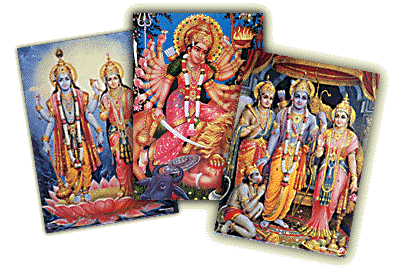
Posters from left to right: Vishnu and Lakshmi, Durga, and Rama with Lakshman (left), Sita (right), and Hanuman (kneeling).
|
Why are there so many different forms of the deities?
|
Hindu deities are the sum of all of existence: masculine and feminine, sadness and happiness, creation and destruction, disease and health. Each deity may have several manifestations, each one representing a different side of the deity's personality. In addition, Hindus believe in reincarnation, and some of the deities themselves have many incarnations. The god Vishnu, for example, is said to have had ten incarnations.
Most images in Hindu temples and shrines are permanent and impermeable. Carved of stone, cast in metal, or painted on cloth, they may remain in one spot for centuries or even thousands of years. In some shrines, however, the icon of the principal deity is sculpted of an impermanent material and may be immersed in a river or left to disintegrate after the puja. Shrines themselves may also be transitory. Some rituals are enacted only once a year in conjunction with a seasonal change, while others respond to a specific need, such as relief from drought or protection from epidemic. For any of these irregular events, a temporary shrine may be built and then dismantled after use.
Many images of deities are anthropomorphic, that is, they are painted or sculpted to represent the deity in human or superhuman form. Others are abstract or amorphous-a tree, a rock, a pot, a cone, or a stake. Any of these objects, whether anthropomorphic or abstract, can be invested with the holy and powerful spirit of the deity.
|
Where do Hindus worship?
|
Hindus commonly conduct pujas in shrines in three different environments: in temples, in the home, and in outdoor public spaces. It is equally common for any of the deities to be worshiped in any of these three types of shrines.
Hindus believe that if proper care is not taken of a temple's images, the deity will abandon the temple. Hence priests reside at the temple and take care of the gods' needs. Priests perform puja at sunrise, noon, sunset, and midnight. For a layperson, however, visiting a temple every day or even regularly is not mandatory, and many devout Hindus worship at home. The essential aspect of puja is not congregational worship but an individual's offering to a deity. Worship in the home usually takes place daily. |
|
|
Comments
Post a Comment